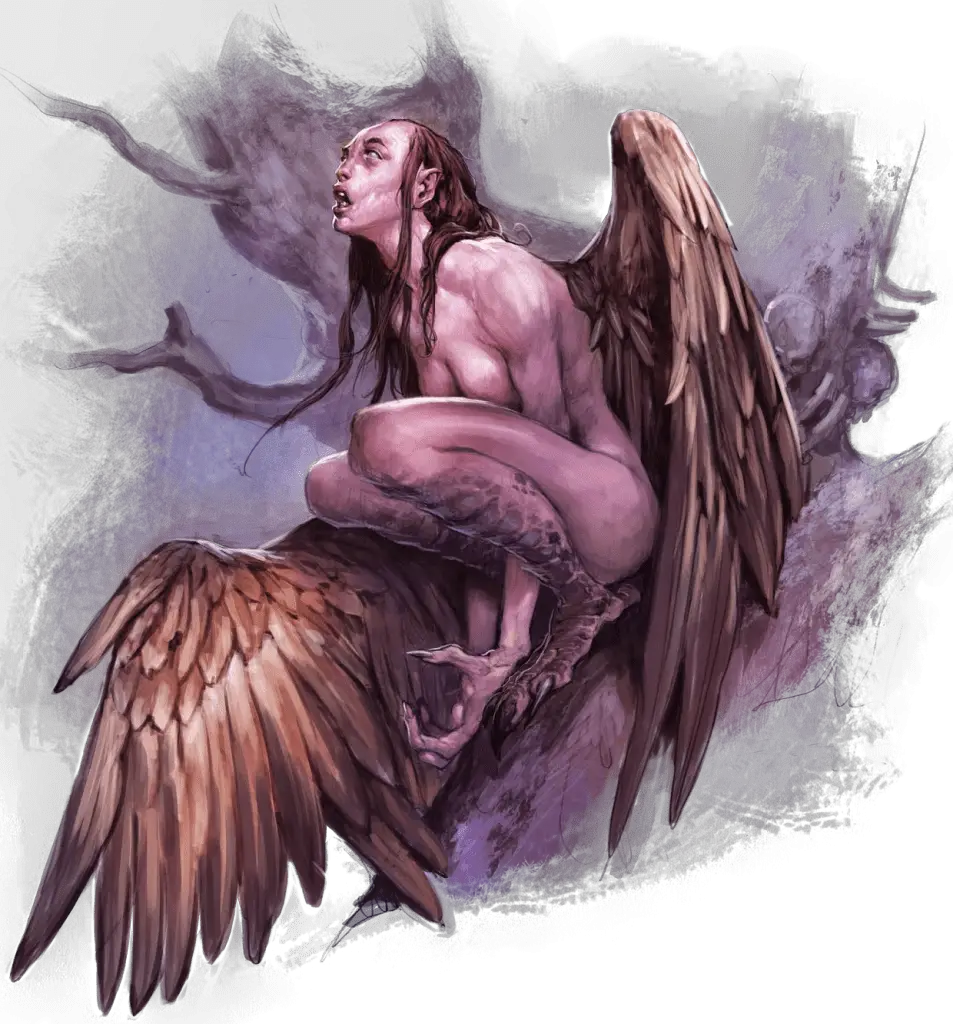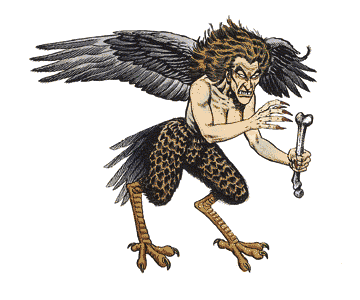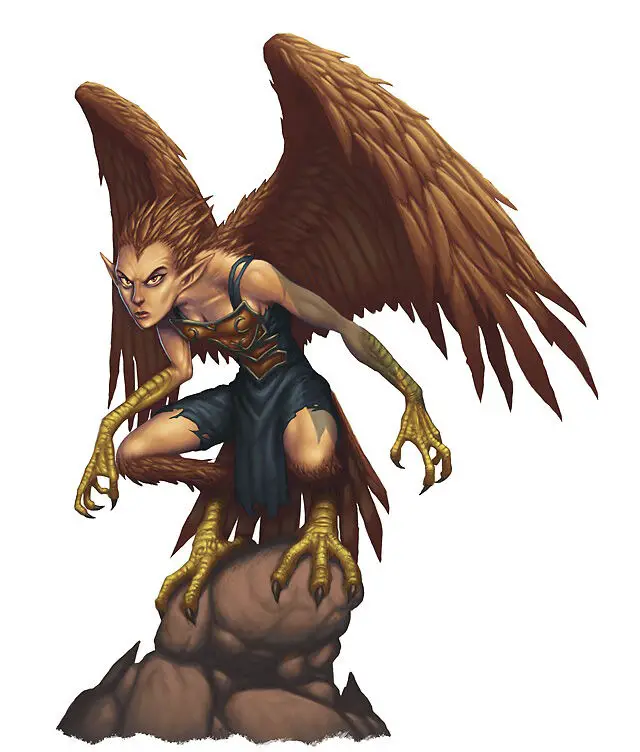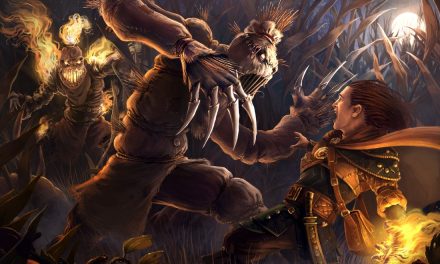There are tons of terrifying monsters to encounter in D&D 5e, but the Harpy is one that easily stands out.
Even though these winged monstrosities are a low Challenge Rating (CR 1 to be exact), they can spell certain doom for low-level adventuring parties. Given the right circumstances, even a mid-level party could quickly find themselves overwhelmed!
You might want some earplugs to help you resist these creatures’ enchanting songs. Today we’re taking a closer look at the Harpy in D&D 5e!
In this article, we’ll cover the Harpy’s lore as well as give some ideas for what an encounter with these foul creatures might look like!
Harpy Lore in D&D 5e
There’s actually a lot of very interesting lore for harpies in D&D 5e.
The Harpy’s origin is somewhat like that of the Medusa in that it was a curse that led to the creation of something so foul. However, while the Medusa is cursed individually, the Harpies were all created by the curse that spawned the first of its kind.
We’ll cover the legend of the first Harpy in just a moment. Let’s first start with what they look like!
Appearance
Harpies have the torso, arms, and head of a female humanoid. However, they have the wings, bodies, and legs of a large vulture.
Their hair is often long and stringy and rows of razor-sharp teeth fill their mouths. Harpies don’t bother with clothing but may wear jewelry or grim souvenirs of their previous victims.
The Harpy’s preferred method of attacking their prey is with their sharp and jagged talons. But they’ll also strike out with clubs made of bone or some other such material that they’ve found. While a Harpy is quick to brandish its talons, they’ll likely be seen carrying a discarded femur or some other kind of crude weapon.
Considering that the Harpy’s enchanting song is their most prevalent ability, it might be tempting to describe one as initially beautiful.
Honestly, I think that that cheapens the terror of the encounter.
To a charmed target, they might view the Harpy as the most beautiful and enchanting creature they’ve ever seen. But to those who aren’t charmed, there should be no doubt about what kind of monster they’re seeing.

Harpy Society
While there are, in fact, both male and female harpies, the two look exactly the same.
This is a result of a type of cruel selective breeding in which Harpies devour any of their young that are “deformed.” Of the twenty or so eggs that a Harpy lays at a time, only a very few (two or three) will ever hatch and mature.
For those that do mature, most will have a lifespan of up to 30 years. If some group of adventurers doesn’t slay them, they’ll be attacked by their own kin when they’re perceived as being too old or weak. Some may live up to 50 years, but that’s rare!
There’s no mercy in Harpy societies and even a group that nest together (called “screams” instead of flocks) tend to have a very tense relationship with each other. They’ll constantly squabble, argue, and even fight each other to the death.
Because Harpies are exclusively carnivorous, they’ll take whatever meat they can get: even their own kind. However, elves (which are naturally resistant to Harpies’ charms) are particularly viewed as a delicacy.
A “scream” of harpies can range from as small as six members to as many as two hundred.
One of these “screams” may cooperate with some other being if their interests are met. It’s possible that an evil warlord or a crafty hag has managed to reason with the harpies by promising them a steady flow of prey.
While treasures serve as trophies for Harpies, they care less about wealth than they care about food!
You Might Like: D&D Storytime – That Time My Halfling Freed A Bunch of Genies
Cursed Sirens – Harpy Origins
The legend goes that the first Harpy was created by a curse put upon a young elf woman.
Wandering the elven forests many centuries ago, the young elf heard the most enchanting birdsong. It was so beautiful and pure that it moved her to tears. Entranced, the elf followed the music deeper into the forest.
When she arrived at the source, she found a handsome young male elf who had also been listening to the bird’s song. As it just so happened, this was the elf God known as Fenmarel Mestarine.
The girl was awestruck by the young man’s beauty. However, he was reclusive and fled deep into the forest.
No matter how hard she looked, the girl couldn’t find any trace of the boy. As she began to cry, the girl begged the Gods to help her.
Aerdrie Faenya, the elven Goddess of the sky, heard the girl’s pleas and came to assist her.
Taking the form of the bird that had first drawn both Fenmarel and the elven girl, Aerdrie sang the birdsong to call out into the forest. By teaching the young girl this song, perhaps she could meet this stranger again.
But, alas, Fenmarel did not appear.
The girl grew angry and began to curse the Gods. In her rage, she invoked a dark power that transformed her into a gruesome mixture of humanoid and bird: the first Harpy.
What was once a desire for love was replaced by a hunger for flesh. Calling out with the enchanting song taught to her by Aerdrie, the girl (if any trace of who she once was still remained behind this monstrous form) lured unwitting creatures to her.
This girl had now become a monster with no goodness left in her.
With only dark malice in her eyes and hatred in her heart, some may still hear her singing in the distance. Those who are wise will quickly move the other way…

Harpy Cruelty
What the Harpy lacks in cunning, it makes up for in cruelty.
These creatures look for easy prey that they can ambush without much of a fight. Clearly harpies were never taught not to play with their food and have instead made it into a type of game.
If a target looks like it might make a lot of screaming noises while the harpies attack, that’s even better! To a harpy, these screams of fear and agony are delightful music.
Harpies enjoy this “music” so much that they might even keep a victim prisoner for several days before eating them just to hear them “sing.”
There are plenty of monsters in D&D 5e with the Chaotic Evil alignment, but few are as deserving of that as the Harpy!
Also Check Out: Overcoming Imposter Syndrome for Dungeon Masters
Harpy Lairs and Treasures
Harpy lairs house the loot and treasures that have been picked off of previous victims.
Shiny objects or those of some obvious value tend to be most attractive to harpies. (In fact, they’ll often fight over who gets what from their victims!)
It’s very likely that adventurers can find coins, jewelry, or even magical items in the Harpy’s hoard. However, they’ll also find themselves digging through the filth, refuse, and grim remains of those who have fallen prey to the Harpy.
The lair itself is likely hidden and remote. It’s a safe assumption that it will take some careful climbing to reach it!
Remember: Harpies tend to be cowardly so it only makes sense that their lair is somewhere hard to reach where they can easily keep watch on their surroundings.
While they’re not necessarily intelligent enough to use tactics in combat, the terrain around Harpy lairs does lend itself to making them even more dangerous.
Enchanted by the Harpies’ mesmerizing song, an adventurer could quickly find themselves stepping off of a mountain pass and falling to the rocks below.
To face a group of Harpies is to also face the hazardous terrain that they inhabit!

Harpies in Combat
So now that we’ve covered the lore behind the Harpy in D&D 5e, let’s get into some mechanics.
We’ll first look at how a DM might incorporate Harpies into their adventure. From there, we’ll look at some player tactics and strategies that make it more likely your character will survive the encounter!
Using Harpies as a DM
Harpies aren’t interested in a fair fight and will only attack when they’re reasonably sure that they can win. If the tables turn, they’ll be quick to fly away and possibly strike again later.
Looking over the Harpy’s stat block, we see that these are creatures who excel at ambushing their prey and using their flying speed to keep the most advantageous position possible. With 40 feet of movement, they should have little difficulty swooping in to attack the party!
With a low AC of 11, the Harpy is pretty easy to hit. If it can’t get back to a position that the party will have a difficult time hitting it, it probably won’t last more than a couple of rounds.
Even though they don’t have the highest Intelligence or Wisdom scores, Harpies would know to attack someone who is separated from the rest of the party. If a member of the party gets distracted or just happens to be in the back of the marching order, that’s a prime target for the Harpy.
It’s also not unlikely that a Harpy might take some delight in trying to drop its target and let gravity do the work.
Related: Falling Damage in D&D 5e Explained
We’ll go into some more specific detail about using the Harpy’s Luring Song in a moment, but it’s the same idea: Harpies favor easy prey.
If a Harpy can’t quickly drop a target in a round or two, it becomes more trouble than it’s worth and they’ll likely fly away.
Of course, that doesn’t mean that they won’t make an attempt to stalk the party and try again later. The party may find themselves engaged in another combat later. Having trailed the party and seeing that they’re distracted, the Harpies may swoop in again.
Harpies may not be particularly cunning, but there’s no reason to think they aren’t persistent!
By the way, if you’re looking to really add a new level of tactics to your combats in D&D 5e, I’d recommend checking out my review of The Monsters Know What They’re Doing. This book is an absolute gem that should be on every DM’s shelf!
Using the Harpy’s Luring Song Feature
Of course, Harpies will also be quick to use their Luring Song feature to charm and quickly deal with any adventurer who isn’t able to make their saving throw!
Be forewarned: the Harpy’s Luring Song has the potential to be a TPK!
Every humanoid (and giant!) within 300 feet of the singing harpy that can hear them has to make a DC 11 Wisdom saving throw. If they fail, they are charmed by the Harpy. While charmed in this way, the creature is incapacitated and not able to be affected by other harpies’ songs.
Keep in mind, with a range of 300 feet, the party is very likely making saves well before they even see the Harpy!
The Harpy can use its bonus actions to continue singing the song. Until they stop singing, the target is charmed and has to use its movement to get closer to the Harpy via the most direct route.
As it just so happens, the most direct route can very easily lead to a character moving directly into a natural hazard.
They might fall off the side of the mountain pass, try to swim through a river with a strong current, or cross a rope bridge that isn’t exactly up to code. They’ll have to live with the consequences of the path they take, but that might not be a very long time at all…
The charmed creature can repeat the saving throw at the end of each of its turns. Additionally, they get another saving throw before stepping into a hazard or when they take damage from something other than the Harpy that has charmed them.
Keep that in mind: while the victim is charmed, the Harpy is able to attack it without breaking the charm effect!
DC 11 is a pretty low save, so you’ll want to have the Harpies engage quickly after charming their target!
If a character successfully saves against the Harpy’s Luring Song, they’re immune to that specific Harpy’s song for 24 hours. However, they’ll need to repeat the save if another Harpy starts singing.
Fighting Harpies as a Player
More than likely, your party will be encountering Harpies at lower levels.
At these levels, the Harpy’s multiattack can be outright terrifying. If you’ve only been fighting goblins and such with the standard single attack per turn, the flurry of claws and swinging clubs from the Harpy can be quite the wakeup call!
If someone in the party drops to zero hit points, prioritize getting them back up as soon as possible. The Harpies will have no problem grabbing your unconscious ally and flying back to their lair to eat!
Of course, the biggest issue here is the Harpy’s flying speed.
If the party is of a high enough level for one of the spellcasters to cast the Fly spell, this encounter will be much easier. After all, the Harpy’s greatest strength is its flying speed. However, that may not be the case!
Spells and ranged weapons are going to be your best bet.
When the Harpies swoop in, the melee combatants in your party need to hit hard and fast. It’s a great time for the Fighter to use their Action Surge or the Paladin to use their Divine Smite.
After all, if you can’t deal with the Harpies now, you’ll almost certainly have to deal with them again later!
Furthermore, look out for hazards like pits or unstable footing. The odds of failing multiple DC 11 Wisdom saves to resist the Harpy’s song are low, but they’re never zero!
If there are multiple Harpies, you’ll want to take extra care!
By some good fortune, if your party knows that they’re going into an area with Harpy activity, you might ask your Bard, Cleric, or Ranger to keep the Silence spell handy as well!
Conclusion – The Harpy in D&D 5e
The Harpy actually goes back to the earliest editions of D&D. Between that and its origins in Greek mythology, this is a creature with some major history!
There’s something particularly unsettling about them. The duality between being able to sing a song so beautiful that it entrances those who hear it and the flesh-eating monstrosity singing the song makes for an interesting encounter.
The Monster Manual itself even describes the Harpy’s song as “music more beautiful than anything else in the world.” It makes me wonder if there’s a potential adventure hook here for Bards that might be interested in learning more about the song…
Anyhow…
If you like monsters based on real mythology as much as I do, you should check out this other article I wrote. In that article, I compare and contrast different D&D monsters with their roots in real-world mythology!
Want to stay up-to-date with all of the latest tips, tricks, guides, and more for D&D 5e? Subscribe to my newsletter using the form below! I’ve got some great stuff planned for the near future you won’t want to miss out on!
Have questions about Harpies in D&D 5e or suggestions for my next monster article? Let’s talk in the comments!










